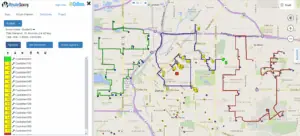More and more business fleet operators are introducing programs to help prevent distracted driving for fleets. This is a smart move that can improve safety, save lives & potentially reduce or at least maintain insurance rates.
Did You Know:
When your business fleet driver takes their eyes off the road for 5 seconds at 55 MPH, it’s like driving the length of a football field with their eyes closed.
(Source: National Highway Transportation Safety Association.)
What Is Distracted Driving?
The Centers for Disease Control and Prevention defines distracted driving as anything that takes your attention away from driving. The top 3 types of distraction include:
- Visual Distractions – Taking your eyes off the road to look at a web map, change the music channel, or look at a text.
- Manual Distractions – Manual distractions occur when a driver takes her/her hands off the wheels to text, manipulate their smartphone, grab food & more.
- Cognitive Distractions – Activities that take the driver’s mind off of driving, including navigating, interacting with a navigation device, listening to music, and more.
The High Costs of Distracted Driving: Why Fleet Operators Should Make It A Priority to Prevent Distracted Driving for Fleets
Distracted driving has been studied intensively in recent years, and the numbers don’t lie. The costs of distracted driving are enormous. Here are some rather mind-boggling statistics on the costs of distracted driving.
- Drivers are 3 times more likely to get into a car crash when performing manual-visual tasks like reaching for a phone or watching a web map while driving. (Source: Virginia Tech Transportation Institute)
- 9 people die in car crashes every day in the United States due to distracted driving. (Source: Centers for Disease Control & Prevention.)
- 1,000 people are injured car crashes every day in the United States due to distracted driving. (Source: Centers for Disease Control & Prevention)
How RouteSavvy Helps Prevent Distracted Driving for Fleets
Most folks know that RouteSavvy Route Optimization Software helps fleets operate more efficiently by saving time and money. An added benefit of route optimization software is that it helps prevent distracted driving for fleets by providing audio turn-by-turn navigation. Here’s how:
- The fleet manager develops an optimized route for fleet drivers using RouteSavvy.
- That optimized route can certainly be provided in a print-out.
- The best option to prevent distracted driving for fleets is to use a RouteSavvy Button called “Mobile.”
- When you press this “Mobile” button in RouteSavvy, it makes the optimized route available for a mobile user and is designed to work on virtually all smartphones.
- Smartphones that have a navigation app installed (Google Maps or Waze, which is owned by Google Maps) can then provide audio of turn-by-turn navigation instructions to the stops listed in the optimized route.
- As drivers need to go to the next stop on their route, they simply press the Google or Waze button Google or Waze will provide turn-by-turn navigation instructions verbally. This eliminates the need for fleet drivers to be watching a mapping screen so they can keep their eyes on the road.
- In addition, RouteSavvy provides navigation instructions to the next stop on the list based on wherever you are at the time, instead of the previous destination or stop. This allows drivers to stop for lunch, get gas, or make a quick pit-stop somewhere, and still get accurate directions to the next stop.
Benefits of Route Optimization Functions That Help Prevent Distracted Driving in Fleets
There are obvious benefits to programs & technologies like route optimization software that help prevent distracted driving in fleets:
- Improve safety
- Save lives
- Potentially reduce insurance premiums
The bottom line is that route optimization software tools like RouteSavvy.com play an important role in helping prevent distracted driving in fleets. When RouteSavvy is deployed, it saves time, money & lives.
If you’ve not yet signed up for RouteSavvy, sign up for our Free 14-day Trial.




